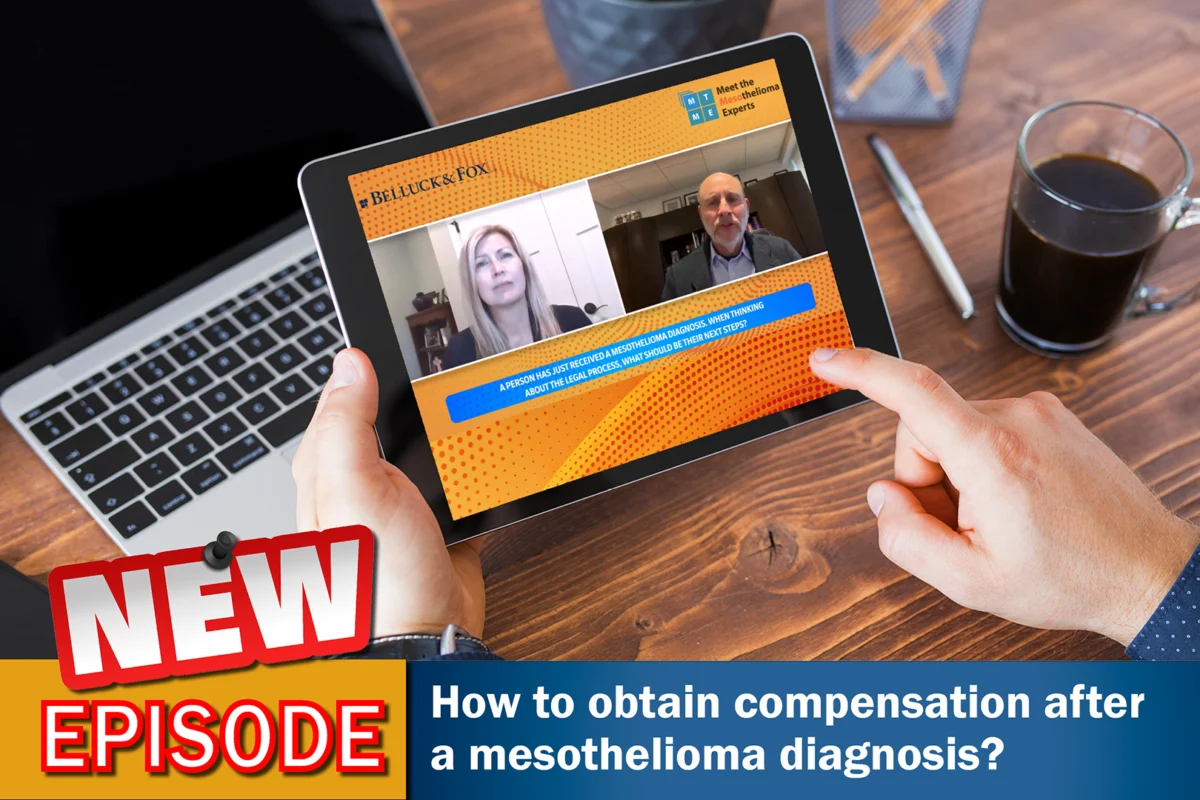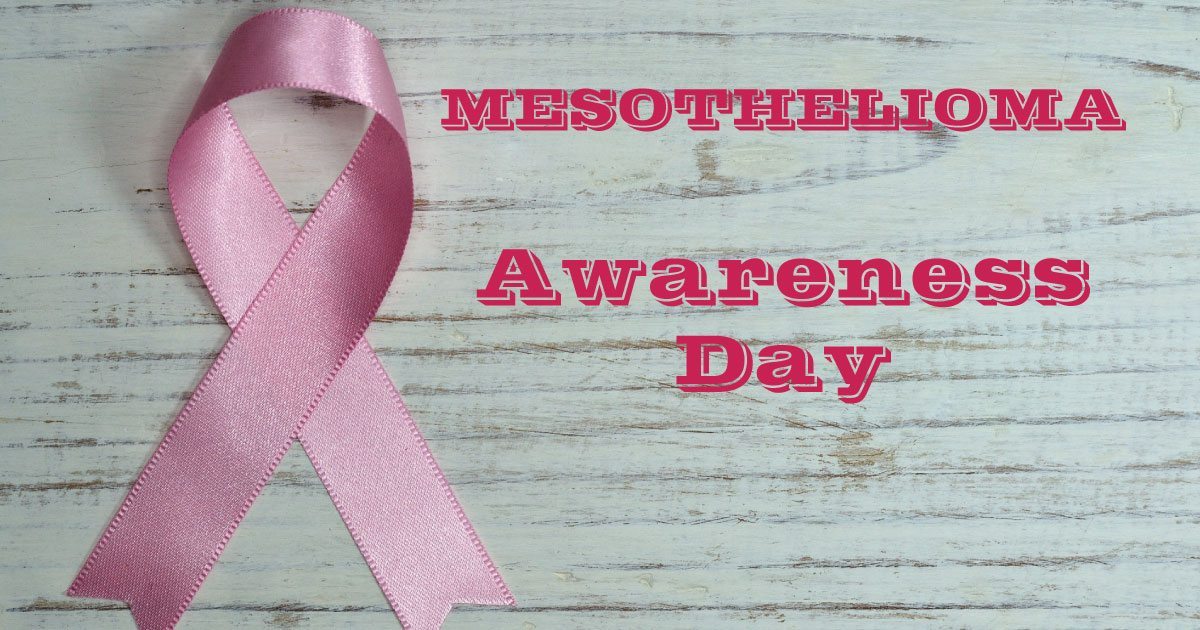Category: National News

New episode of Meet the Mesothelioma Experts About Financial Compensation for Mesothelioma
Last week, the Mesothelioma Applied Research Foundation released a new episode of its Meet the Mesothelioma Experts: Legal Edition series discussing financial compensation issues for mesothelioma patients. Featured guest of the program was Joseph Belluck, partner with the Belluck & Fox firm, who was interviewed by the organization’s board of directors’ member, Cheryl Bruner. Mr. Belluck answered a number of questions of interest to those who have just had a mesothelioma diagnosis and their families.
Acting with Urgency
One of the take-home messages is that while a mesothelioma diagnosis requires medical urgency and treatment, so does the legal process. This is due to a number of issues, the statute of limitations being one, but not the only one. As Mr. Belluck states in this program, it is important to file a lawsuit as soon as realistically possible in order to get a place in line, even if later adjustments are necessary. An experienced law firm will know enough information about a case very quickly and will be able to proceed with expedience.
“Usually, right after contact, we file the case, we start working on the bankruptcy trust claims and also starting to work on the lawsuit, which we do in tandem. Typically, the first settlements will come in about 45 – 60 days and the whole case will be completed within 12 months,” said Mr. Belluck in the program.
Mr. Belluck adds that whether a patient chooses to hire his firm or another firm, he still encourages them to make sure to do so quickly for the reasons outlined above.
Watch the video:
00:00 Introduction
1:11 Why Belluck & Fox chooses to sponsor the Meso Foundation and how their mission resonates
6:15 How Belluck & Fox works within the meso community
7:47 Next steps in the legal process after diagnosis
11:05 Litigation timeline after choosing a law firm
14:01 How much time and effort is anticipated to dedicate to litigation
16:14 Options for taking legal action
21:58 Timeline of settlement funds
28:05 How much of a settlement does a patient/family receive
35:37 Advice for future clients in deciding legal action
Compensation Programs for Mesothelioma Patients and their Families
There are several main compensation programs that are typically available to mesothelioma patients. They include simple programs like health insurance, private disability insurance, social security disability benefits, and workers compensation if the person is still employed. Additionally, veterans’ benefits are available for people who served in the military and have a service connection to asbestos exposure. Mesothelioma bankruptcy trusts are another avenue to pursue for compensation. There are about 40-50 individual funds that have been set up by companies that made asbestos products and went into bankruptcy. As part of their bankruptcy reorganization, they set up a fund for their product. And the last option available is to file a lawsuit individually, not a class action, against the companies that made asbestos products that the patient was exposed to.
Mr. Belluck and his law firm offer free consultations by submitting a quick form on the firm’s website at www.belluckfox.com.

September 26 Is National Mesothelioma Awareness Day
Each year, the mesothelioma community across the nation comes together for Mesothelioma Awareness Day, a time devoted to raising public awareness about the life-threatening cancer and its cause ─ exposure to asbestos.
Patients, family members, friends, advocates and health care professionals are encouraged to share their personal stories, struggles and inspiration in order to bring attention to the disease and further the search for a cure.
When Is Mesothelioma Awareness Day?
Mesothelioma Awareness Day is held on Sept. 26. In 2018, September 26 falls on a Wednesday.
In an effort to expand the impact of Mesothelioma Awareness Day, advocates have encouraged patients, caregivers, family and friends to participate in Mesothelioma Awareness Week surrounding Sept. 26, as well as Mesothelioma Awareness Month throughout September.
Mesothelioma Awareness Day History
In 2004, the Mesothelioma Applied Research Foundation organized the original Mesothelioma Awareness Day. Since then, the national nonprofit organization has continued to build momentum by promoting the day as a time for all those touched by the cancer to talk about its impact.
In 2010, Congress joined the effort by establishing Mesothelioma Awareness Day as a time for the nation to recognize that thousands of Americans are diagnosed with the preventable cancer each year. In fact, despite its designation as a known carcinogen, asbestos is still not banned in the United States, and Americans are still at risk of exposure.
The Importance of Awareness Day
The National Mesothelioma Awareness Day resolution asks that the President of the United States issue a proclamation calling for all Americans, federal agencies and departments, state governments, local municipalities, organizations, and news media to properly observe the day.
The Congressional Declaration outlines these key facts about malignant mesothelioma as reasons for promoting awareness of the deadly asbestos cancer:
- Although workers who were exposed to asbestos on a daily basis over a long period of time are most at risk of developing mesothelioma, even short-term exposures can cause the disease. In fact, exposure to asbestos for as little as one month can result in mesothelioma 20 to 50 years later.
- Asbestos materials were used in the construction of virtually all office buildings, public schools, and homes built before 1975. Still today, asbestos is used in more than 3,000 products being sold in the United States.
- The National Institutes of Health reported to Congress in 2006 that mesothelioma is a difficult disease to detect, diagnose and treat.
- For decades, the need to develop treatments for mesothelioma was overlooked. Still today, even the best mesothelioma treatments usually have a very limited effect, with the expected survival time of 8 to 14 months.
- It is believed that many of the firefighters, rescue workers and police officers from Ground Zero on September 11, 2001, may be at increased risk of developing mesothelioma in the future due to asbestos exposure at the site.
Every year, about 3,000 people in the United States are diagnosed with mesothelioma. Around the world, an estimated 38,400 people die each year from the devastating asbestos illness.
Unfortunately, those numbers are not dwindling. Mesothelioma statistics indicate an increase in deaths in recent years, with an 8 percent increase in fatalities in the United States for the 10-year period that ended in 2015.
These facts point to the importance of Mesothelioma Awareness Day in educating people about the dangers of asbestos and promoting the need for continued research into more effective treatments.
Paint the World in Mesothelioma Awareness
Just as breast cancer is associated with the color pink, support for mesothelioma awareness is often represented by a colored ribbon. The mesothelioma awareness color is blue or pearl.
Friends and family members of patients typically don pearl or blue ribbons in a show of solidarity with their loved ones who are fighting the life-threatening disease.
The Mesothelioma Applied Research Foundation also encourages people to participate in its “Paint the World in Mesothelioma Blue” campaign to raise awareness by wearing blue and sharing photos of themselves on social media.
How You Can Show Support on Mesothelioma Awareness Day
Since its founding, the nonprofit Mesothelioma Applied Research Foundation has advocated for patients and families while coordinating fundraising events to support research efforts related to the disease. This national organization is committed to finding a cure for mesothelioma and ending the suffering it causes.
One way to show your support on Mesothelioma Awareness Day is to make a donation to the Meso Foundation. Your contribution will help fund the organization’s efforts to support mesothelioma patients and the ongoing search for a cure.
You may also choose to show your support by wearing (and asking others to wear):
- Mesothelioma awareness ribbons
- Mesothelioma awareness pins
- Mesothelioma awareness bracelets
- Mesothelioma awareness wristbands
- Mesothelioma awareness shirts
At Mesothelioma Help Cancer Organization, we aim to raise awareness year-round, in particular through our Mesothelioma Awareness Scholarship Contest. As part of this contest, students submit essays sharing their own experiences with mesothelioma as well as their efforts for raising awareness of the dangers of asbestos. We encourage the students to share their essays on social media to help spread the word.
Quick Facts to Share on Mesothelioma Awareness Day
- Asbestos is the only known cause of mesothelioma. It has also been shown to cause lung cancer.
- Asbestos was commonly used on Navy ships and in shipyards. Veterans account for approximately one-third of mesothelioma diagnoses.
- Industrial workers and construction workers are at an increased risk of developing mesothelioma and other asbestos diseases.
- Family members of those who worked with asbestos may have faced secondhand exposure through fibers brought home on clothing or skin.
- Although the U.S. government has safety regulations in place, it has not banned the use of asbestos.
- There is no safe level of asbestos exposure.
- Renovation projects on older homes and demolition of older buildings can put people at risk of asbestos exposure.
- Never try to remove asbestos materials on your own. Contact an asbestos abatement professional.
- Companies that made asbestos products understood the health risks but failed to warn the public.
- Mesothelioma patients and families may be entitled to compensation for damages due to asbestos exposure.
- Even if an asbestos company has gone out of business, funds may be available in a bankruptcy trust for mesothelioma victims.
Sources:
- Mesothelioma Applied Research Foundation
https://www.curemeso.org/get-involved/get-involved-events/mesothelioma-awareness-day - Make a Donation
https://www.curemeso.org/donate

Department of Defense Increases Funding for Mesothelioma Research
It’s well known that veterans are at higher risk of asbestos-related diseases because of the wide use of the dangerous mineral fiber in thousands of buildings and Navy ships from World War II until the 1970s.
Now, the U.S. Department of Defense has announced plans to increase spending on research into new ways to combat the fatal disease linked to asbestos exposure.
The Department of Defense’s effort includes funding of several million dollars for three mesothelioma research projects. The funds will support research into early detection of the disease and the development of new treatments, including clinical trials on a vaccine that could improve the prognosis for patients with mesothelioma.
Mesothelioma is a cancer of the lining of the lungs, caused by inhaling asbestos fibers. The microscopic fibers become lodged in the lungs and can lead to development of respiratory diseases including mesothelioma, lung cancer and asbestosis decades later.
Joseph Belluck, a partner in Belluck & Fox, LLP, a New York law firm that specializes in representing victims of asbestos related diseases, said the increase in research funding must be only the start of an effort to find a cure for asbestos-related disease that has killed thousands of veterans.
“Veterans who were willing to fight for their country now must have their country fight for them,” Belluck said.
The shipbuilding acitivities from before World War II until the 1980s exposed thousands of Navy veterans to asbestos exposure on a daily basis.
During World War II, several million people employed in U.S. shipyards and U.S. Navy veterans were exposed to chrysotile asbestos products as well as other forms of asbestos that were used extensively in military ship construction, according to the Department of Veterans Affairs. Asbestos was widely used in shipbuilding to insulate boilers, steam pipes and hot water pipes.
Veterans involved in mining, milling, shipyard work, insulation, demolition of old buildings, carpentry and construction, manufacture of brake linings and clutch facings and manufacture of pipes. Veterans may be eligible for health care and disability compensation if the VA determines the asbestos exposure was related to military service.
Learn more about VA health care and disability compensation at http://www.publichealth.va.gov/exposures/benefits.asp.
Also, know more about mesothelioma and how you can deal with it.

University of Hawaii Researchers’ Glowing Bunnies May Someday Bring Genetic Therapy to Mesothelioma Patients
Fluorescent protein taken from a jellyfish DNA and injected into a rabbit’s embryos has produced a litter with several glow-in-the-dark bunnies. Although to many, this may seem like science fiction, to researchers, scientists and physicians this means more effective medicines and cures for diseases like hemophilia, Alzheimer’s, and cancers such as mesothelioma, may be on the horizon.
According to a press release, a team of researchers from the University of Hawaii at Manoa and the University of Istanbul in Turkey used transgenesis to take a genetic marker from one animal and introduce it into another that did not originally have the gene – in this case, from the jellyfish to the rabbit. Although two of the newborn bunnies were left with an eerie glow when seen under black lights, they are otherwise perfectly healthy and are expected to lead full rabbit lives.
Now, the researchers are awaiting the birth of glowing lambs anticipated to be born in November. The same experiment was conducted in the larger mammal to forward the process towards work with humans.
Unfortunately, this type of work is controversial in the United States, and the experiments are being conducted in Turkey. In an interview with KHON2 of Hawaii, Dr. Stefan Moisyadi, lead researcher from UH, said, “At home, there is this hysteria that transgenic animals should not be used for anything.” But he adds, “The benefits in doing it [the experiments] in large animals is to create bio-reactors that basically produce pharmaceuticals that can be made a lot cheaper.”
Gene therapy has been touted as the “new frontier” in medicine and is offering hope to patients and doctors alike that once untreatable diseases, including mesothelioma, may now be cured. The cost, however, is often extremely high. Dr. Moisyadi told Independent.co.uk, “we can make those enzymes a lot cheaper in animals with barrier reactives rather than a factory that will cost billions of dollars to build.”
Tracking Asbestos and Other Environmental Pollutants
Mesothelioma is just one of the diseases that is caused by exposure to environmental pollutants. The National Cancer Institute explains that when asbestos fibers are breathed in, they may get trapped in the lungs and remain there for a long time. Over time, these fibers can accumulate and cause scarring and inflammation, which can affect breathing and lead to serious health problems. Mesothelioma, lung cancer and asbestosis are all associated with asbestos exposure.
The research with glowing animals can also be used to help track pollutants as they travel through the body. Researchers from the University of Tennessee have developed transgenic bioluminescent zebrafish that were engineered exclusively to emit a glow when elevated levels of ammonia or nitrate are present in the aquarium and enter the fishes’ bodies. These “environmental reporters” can lead the way to produce other processes that can detect a large number of chemicals or toxins, potentially screening processes.
While all of this research still requires many more years of studies and work in the labs, genetic research appears to be pointing to many promising breakthroughs in the medical field.
About the Researchers
UH Emeritus Professor Ryuzo Yanagimachi who is the founder of the UH Manoa Institute for Biogenesis Research helped set up the initial experiment with the Turkish researchers. Yanagimachi, according to UH, is “recognized around the world as the scientist whose early work with animals laid the foundation for the development of in vitro fertilization in humans.” He also invented the now common technique used in fertility clinics for inserting sperm into an egg. Dr. Stefan Moisyadi, associate professor, then took over the experiment and is the lead researcher on the project.
Know more about Mesothelioma here.
Sources:
- University of Hawaii at Manoa
http://www.uhm.hawaii.edu/news/article.php?aId=5906 - Independent.co.uk
http://www.independent.co.uk/news/science/team-of-scientists-create-cloned-glow-in-the-dark-rabbits-8756928.html - KHON2 of Hawaii
https://www.khon2.com/news/local-news/researchers-study-nature-of-sharks-in-hawaii-waters_2018030911381013/1025616452
The Link Between Mesothelioma and Working in Taconite Mines
Researchers at the University of Minnesota have confirmed a correlation between the risk of mesothelioma and the amount of time that workers spent in taconite mines. Mesothelioma is an aggressive cancer of the lining of the lung and abdominal cavity. It’s generally associated with exposure to another mineral fiber, asbestos, linking the disease to occupations where asbestos was used.
The findings which will be presented to the Minnesota Legislature were part of an ongoing 5-year, $4.9 million study of Taconite workers’ health.The researchers said that a person’s risk of getting mesothelioma increased by three percent for each year they works in a taconite mine. The study is potentially groundbreaking because the type of mineral fibers present in iron ore mining have not been previously linked to mesothelioma.
“One important finding of the work to date in that the risk of contracting mesothelioma is higher across the entirety of the Range among people who worked longer in the industry,” said Dr. Jeff Mandel, a School of Public Health environmental health expert and principal investigator of the study.”
The Minnesota Legislature commissioned the study in 2008 after data from the Minnesota Cancer Registry showed an apparent excess of cases of mesothelioma among Iron Range workers. The study’s objective is to determine whether dust-related lung disease, including mesothelioma, lung cancer and other non-malignant respiratory disease is related to working in the taconite industry.
The researchers found that the causes of death among taconite workers compared to Minnesotans as a group were higher than expected for mesothelioma, lung cancer and heart disease.
The researchers are still trying to determine if the increased risk of mesothelioma among taconite miners is a result of cumulative exposure to the microscopic mineral fibers present in taconite dust. They plan to do further data analysis in coming months.
Source: University of Minnesota School of Public Health Press Release
Free Mesothelioma Patient & Treatment Guide
We’d like to offer you our in-depth guide, “A Patient’s Guide to Mesothelioma,” absolutely free of charge.
It contains a wealth of information and resources to help you better understand the condition, choose (and afford) appropriate treatment, and exercise your legal right to compensation.
Download Now